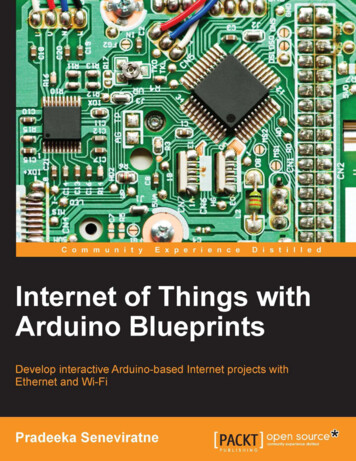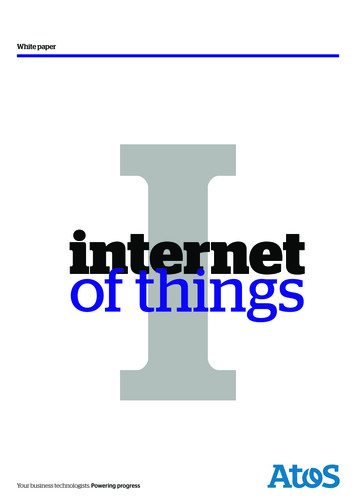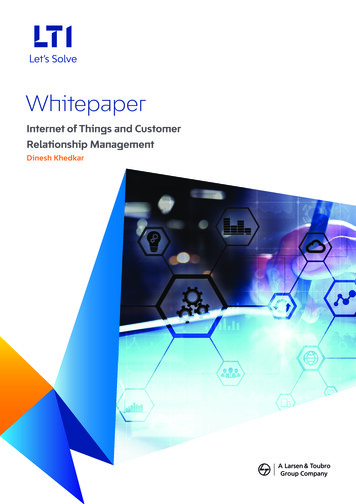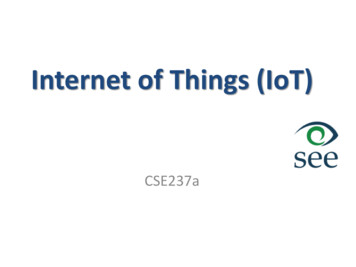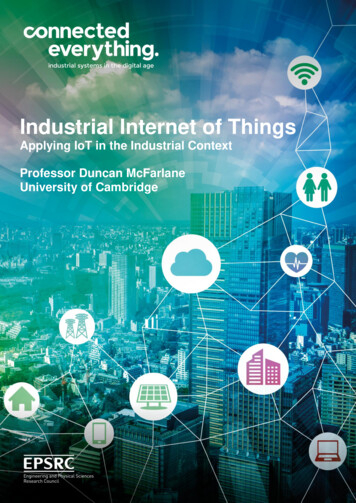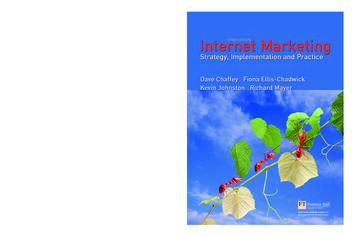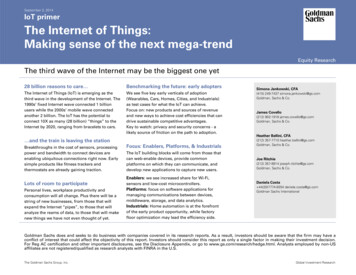
Transcription
September 3, 2014IoT primerThe Internet of Things:Making sense of the next mega-trendEquity ResearchThe third wave of the Internet may be the biggest one yet28 billion reasons to care Benchmarking the future: early adoptersThe Internet of Things (IoT) is emerging as thethird wave in the development of the Internet. The1990s’ fixed Internet wave connected 1 billionusers while the 2000s’ mobile wave connectedanother 2 billion. The IoT has the potential toconnect 10X as many (28 billion) “things” to theInternet by 2020, ranging from bracelets to cars.We see five key early verticals of adoption(Wearables, Cars, Homes, Cities, and Industrials)as test cases for what the IoT can achieve.Focus on: new products and sources of revenueand new ways to achieve cost efficiencies that candrive sustainable competitive advantages.Key to watch: privacy and security concerns - alikely source of friction on the path to adoption. and the train is leaving the stationBreakthroughs in the cost of sensors, processingpower and bandwidth to connect devices areenabling ubiquitous connections right now. Earlysimple products like fitness trackers andthermostats are already gaining traction.Focus: Enablers, Platforms, & IndustrialsThe IoT building blocks will come from those thatcan web-enable devices, provide commonplatforms on which they can communicate, anddevelop new applications to capture new users.Simona Jankowski, CFA(415) 249-7437 simona.jankowski@gs.comGoldman, Sachs & Co.James Covello(212) 902-1918 james.covello@gs.comGoldman, Sachs & Co.Heather Bellini, CFA(212) 357-7710 heather.bellini@gs.comGoldman, Sachs & Co.Joe Ritchie(212) 357-8914 joseph.ritchie@gs.comGoldman, Sachs & Co.Enablers: we see increased share for Wi-Fi,Lots of room to participatePersonal lives, workplace productivity andconsumption will all change. Plus there will be astring of new businesses, from those that willexpand the Internet “pipes”, to those that willanalyze the reams of data, to those that will makenew things we have not even thought of yet.sensors and low-cost microcontrollers.Platforms: focus on software applications formanaging communications between devices,middleware, storage, and data analytics.Industrials: Home automation is at the forefrontof the early product opportunity, while factoryfloor optimization may lead the efficiency side.Daniela Costa 44(20)7774-8354 daniela.costa@gs.comGoldman Sachs InternationalGoldman Sachs does and seeks to do business with companies covered in its research reports. As a result, investors should be aware that the firm may have aconflict of interest that could affect the objectivity of this report. Investors should consider this report as only a single factor in making their investment decision.For Reg AC certification and other important disclosures, see the Disclosure Appendix, or go to www.gs.com/research/hedge.html. Analysts employed by non-USaffiliates are not registered/qualified as research analysts with FINRA in the U.S.The Goldman Sachs Group, Inc.Global Investment Research
September 3, 2014The Internet of Things – What iss it?While the first two stages of the Internet’s development had profound implications for the technoology industry, the implications ofprove even more far-reaching as by its very nature it is a trend that we believe will reach beyond tech tothe Internet of Things will ptouch every industry, from healthcare to retail to oil and gas exploration and homebuilding.What is IoT? The Innternet of Things connects devices such as everyday consumer objectss and industrial equipment onto thenetwork, enabling iinformation gathering and management of these devices via software to increase efficiency, enable newservices, or achievee other health, safety, or environmental benefits. The term was first prroposed by Kevin Ashton, a Britishtechnologist, in 19999 when he was at MIT.Just as the first two waves of the Internet era led to profound changes in the economy, the Internet of Things will create newwthings are connected. Withwinners and leave in its wake a host of losers based on companies’ abilities to adapt to a world whereake an overly broad topic and to help understand the core verticals andd technologies that will be amongthis report, we attempt to tathe first to be disrupted.Making S-E-N-S-E off the technologyIoT will rearrange the tech landscape, again. IoT has key attributes that distinguish it from the “reegular” Internet, as captured by ourm tilt the direction of technologyS-E-N-S-E framework: Senssing, Efficient, Networked, Specialized, Everywhere. These attributes maydevelopment and adoption,, with significant implications for Tech companies – much like the transition from the fixed to the mobileInternet shifted the center oof gravity from Intel to Qualcomm or from Dell to Apple.Exhibit 1: Making S-E-N-S-EE of the Internet of ThingsKey attributes of the IoT and how it differs from the “regular” InternetHope and challenge:The IoT connectsstuff, not just people,leading to greaterfragmentation ofsoftware andhardware amidst anexplosion of dataSource: Goldman Sachs Global Investtment Research.Goldman Sachs Global Investment Research2
September 3, 2014Key verticals of adoptionBy definition, the Internet of Things has enormous breadth that can be difficult to get one’s arms around. In our view, it can bebroken up into five key verticals of adoption: Connected Wearable Devices, Connected Cars, Connected Homes, ConnectedCities, and the Industrial Internet.Exhibit 2: The IoT dHomesTransportationConnectedCarsWearablesOil & GasHealthcareSource: Goldman Sachs Global Investment Research.Goldman Sachs Global Investment Research3
September 3, 2014What is driving the momentum we are seeing today?Why now? Enablers of the IoTA number of significant technology changes have come together to enable the rise of the IoT. These include the following.Key obstacles are gone:the cost of connectivityhas declined at the sametime that new ways toanalyze mountains ofdata have developed Cheap sensors – Sensor prices have dropped to an average 60 cents from 1.30 in the past 10 years. Cheap bandwidth – The cost of bandwidth has also declined precipitously, by a factor of nearly 40X over the past 10 years. Cheap processing – Similarly, processing costs have declined by nearly 60X over the past 10 years, enabling more devicesto be not just connected, but smart enough to know what to do with all the new data they are generating or receiving. Smartphones – Smartphones are now becoming the personal gateway to the IoT, serving as a remote control or hub for theconnected home, connected car, or the health and fitness devices consumers are increasingly starting to wear. Ubiquitous wireless coverage – With Wi-Fi coverage now ubiquitous, wireless connectivity is available for free or at a verylow cost, given Wi-Fi utilizes unlicensed spectrum and thus does not require monthly access fees to a carrier. Big data – As the IoT will by definition generate voluminous amounts of unstructured data, the availability of big dataanalytics is a key enabler. IPv6 – Most networking equipment now supports IPv6, the newest version of the Internet Protocol (IP) standard that isintended to replace IPv4. IPv4 supports 32-bit addresses, which translates to about 4.3 billion addresses – a number that hasbecome largely exhausted by all the connected devices globally. In contrast, IPv6 can support 128-bit addresses, translatingto approximately 3.4 x 1038 addresses – an almost limitless number that can amply handle all conceivable IoT devices.The IoT value proposition – a driver of new product cycles and another leg of cost efficienciesCase study: Verizonsaves 55 million kWhof electricity throughIoT application Revenue generation – Companies are focused on the IoT as a driver of incremental revenue streams based on new productsand services. For example, since the beginning of the year AT&T has introduced a Connected Car service in partnershipwith a number of automobile manufacturers, including Audi, GM, Tesla and Volvo, which offer high-speed 3G or 4Gconnections for a monthly subscription fee of 10. By the end of 2014, 30 of GM’s 2015 vehicle models will have LTEsupport, enabling vehicles to act as a Wi-Fi hotspot with connectivity for up to 7 devices, as well as access to OnStar forremote vehicle access, diagnostics and emergency service. Productivity and cost savings – Businesses are also embracing the IoT to improve productivity and save costs, such ascapex, labor, and energy. For example, Verizon is saving more than 55 million kWh annually across 24 data centers bydeploying hundreds of sensors and control points throughout the data center, connected wirelessly. The result is areduction of 66 million pounds of greenhouse gases per year.Goldman Sachs Global Investment Research4
September 3, 2014Focus on: Pipes, Apps, and ThingsThe pipes: building the infrastructure to connect the world’s devicesStandards in motion:Companies arealready gathering incompeting alliancesto set IoT standardssuch as the IndustrialInternet Consortium(IIC) founded byAT&T, Cisco, GE, Inteland IBMBefore there could be 300 million cars in the USA, there was a program to build the interstate highway system. Without highways,traffic jams would be too big, and folks would still be travelling by train. The same holds true for the IoT today. And its interstatehighway system is less likely to fall out of an ambitious government-sponsored plan than it is from a network of private enterprisesalready well underway. Expanding the telecom, cable, and satellite pipelines that carry traffic through broader Wi-Fi networks is acritical part. But also providing devices with the sensor, memory chips and software necessary to communicate with the pipes is key.The apps: developing the software platforms that will unlock the torrent of dataRiding on this super-charged network of “pipes” will be a wave of data that can be used: to make lives easier (think: turn on your heat before you get home), drive efficiency (think: turn on your washing machine when electricity usage and prices fall in the middle of the night), and help us anticipate things without a trip to a specialist (think: full-body health monitors or car engine diagnostics).But before this can be accomplished, we need to establish common software standards, build reliable platforms (think iOS orAndroid) that others can build from, and develop sophisticated software that can analyze more data than has ever been analyzed(think Big Data) to fully realize the potential of the IoT.The things: identifying where connectivity legitimately adds value and is not merely intrusiveSecurity in focus:A study by HP found70% of the mostcommonly used IoTdevices containsecurityvulnerabilities.One of the biggest stumbling blocks to IoT development is likely to be concerns about privacy and security. (“OK, I now come hometo a warm house, but did I just compromise my credit card and provide people with knowledge of my whereabouts to achievethat?”) Finding the “things” that will genuinely make our lives better, save us money, conserve natural resources, or drive betterefficiencies will be critical to the IoT realizing its full potential. Expect fits and starts just as we saw in the fixed-line Internet(remember walled gardens?) and the mobile Internet waves (think: games). But we identify key areas right now where “things” arebecoming connected: Building and home automation addressing HVAC, security, lighting, entertainment, appliances, and assisted living Manufacturing applications that monitor machinery, connect factories and optimize supply chains Resources such as smart electricity grids and electric vehicle infrastructure.Goldman Sachs Global Investment Research5
September 3, 2014Enablers: framing the IoT opportunityThe Communications Technology and Semiconductors industries are at the center of enabling IoT devices. CommTech companieswill connect the smartphones, tablets, cellular networks, and Wi-Fi networks that are central to allowing so many devices tocommunicate with each other. Semiconductor companies will supply an array of sensors and chips that allow devices to collect data,understand images and motion, process the information and communicate seamlessly.CommTech Impact: from Wi-Fi to the “Fog”CommTech touches so many things across the Internet but we expect to see the most profound impact from the sector on the IoTacross three areas: Wi-Fi, cellular, and “Fog” computing. Wi-Fi. The IoT will require primarily wireless communications. As a result, we expect Wi-Fi to be the key communicationsstandard for IoT, much like DSL/Ethernet was for the fixed Internet and 3G/4G for the mobile Internet. Cellular. In an IoT world, no device will be left off the network. Cellular connections will be needed for hard to reach or mobileobjects (e.g., cars or even health wristbands). The “Fog”: Much has been written about “cloud” computing where data is stored outside of your local device, often on serversin large data centers sometimes thousands of miles from where the data was generated. But in the age of the IoT, we expectmore of the network intelligence to reside closer to the source: what technologists call the network edge or the “fog”. Look forthe rise of fog computing architectures, as most data will be too noisy or latency-sensitive (think: it needs to get there and backsuper-fast) or expensive to be carried all the way back to the cloud.Semis Impact: the age of sensors and moreSemiconductors are found in the most mundane devices nowadays from children’s toys to bottle openers. In the age of the IoT, lookfor an even greater proliferation as devices rely on an increasing number of chips working in tandem to collect, process andcommunicate data. We see the biggest growth in sensors and low-cost microcontrollers.Chips proliferate:A single device cancontain multiplesensors along withchips for processing,connectivity andpower management. Sensors. Sensors have outgrown other semiconductor units by five percentage points over the last two years, and we expectthat trend to continue as they proliferate. IoT devices lean heavily on image, motion, touch and environment sensors, alongwith so-called sensor hubs to manage the sensor traffic and reduce the workload on the central processor to save battery life. Connectivity. Just as with CommTech, connectivity will drive the use of semiconductors to manage the communications,driven by Wi-Fi, Bluetooth, ZigBee, NFC, and other IoT standards. Cheap brains: More devices will use microcontrollers or low-cost microprocessors given their lower price points and powerrequirements relative to traditional semiconductor architecture.Goldman Sachs Global Investment Research6
September 3, 2014Enablers: framing the IoT opportunity (cont.)Two of the key enablers of the IoT are a drop in the cost of sensors and the proliferation of cheap processing. Sales of both sensorsand microcontrollers – low cost chips that act as the brains of the devices – are growing faster than the overall semiconductormarket.Exhibit 3: Sensor growth outstripped the overall semiconductor market from2011-2013 (5% CAGR vs. semis at 0%)Exhibit 4: Microcontroller growth has significantly outpaced thesemiconductor marketIndexed IC units and sensor units to January 2011Market size and unit CAGR5.02.14.5MCU & semi units (indexed to 1998)2.31.71.51.31.1Sensors: 6% CAGR 2004 - 20080.94.03.53.02.52.01.51.00.50.70.0IC units ex. memoryLinear (IC units ex. ul-07Sep-07May-07Mar-07Jan-07Linear (Sensors)Source: SIA, Goldman Sachs Global Investment Research.Goldman Sachs Global Investment d unit growth, 2004 - 2010IC units: 6% CAGR 2004 - 20081.92006 - 2013MCUs: 11% CAGRIC units: 3% CAGR1998 - 2005MCUs: 8% CAGRIC units: 7% CAGRMCUIC unitsSource: SIA, Goldman Sachs Global Investment Research.7
September 3, 2014Platforms: the role of software across the IoTSoftware is a big sliceIDC estimates that1/5th of the moneyspent on IoT will gotowards softwareWith every connected device (remember, market research firm IDC forecasts 28 billion of them by 2020) there will be software toenable it to communicate with other devices and central databases gathering data to make our lives more efficient. But the softwarefor the IoT will be different from the software on our desktops, tablets, or even our smartphones. The first wave of the Internet (fixedline) brought with it common software applications like Microsoft Windows and Google. The second wave of the Internettransitioned to mobile software where Apple’s iOS and Google’s Android systems provided standards that enabled large number ofdevices to easily communicate. The third wave – the IoT – will also require the development of standards to allow heterogeneousIoT devices to communicate and leverage common software applications. On the enterprise side, setting of standards will be adrawn-out process over the next decade, particularly with competing consortiums. On the consumer side, the IoT has already begunto see de facto standards emerge as defined by mobile titans attempting to link and leverage their large installed bases.Enterprise software: from data flow to analyticsMuch like some of the task-specific devices they will help enable, we believe the most successful enterprise IoT software vendorsinitially will target small sub-sectors or specific verticals where they can dominate rather than attempt to offer a one-stop shopsolution. Alternatively they might seek to master a particular stage of the machine-to-machine (M2M) data flow process, such as: managing the communication with connected devices/sensors; providing middleware for integration to data repositories; storing and securing the data; and analyzing and visualizing the data.Consumer software: a platform-centric approach that favors the mobile leaders from the 2nd waveIn the consumer world, it looks to us that the same mobile leaders that came to dominate the second wave of the Internet are bestpositioned to provide the platform-centric worlds that the IoT will likely need. As standards (intentional or unintentional) come intoplace, we expect the pace of innovation to accelerate. New functionality will be enabled by communications compatibility allowingthird party hardware and software providers to layer innovation onto common platforms (like Instagram on an iPhone). As a result,look for two classes of software to develop: The platforms. Standard bearers that will lay the software foundation for others (think: iOS, Android, and others). Theseplatform providers are also likely to seek to dominate the “smarter” device categories where the opportunity is largest. The long tail. Some of the “things” in the IoT will be smarter than others and look for a myriad of third-party providers todevelop them software that powers and analyzes the long tail of devices and sensors that are “less smart.”Goldman Sachs Global Investment Research8
September 3, 2014Platforms: the role of software across the IoT (cont.)A key enabler of the IoT is the emergence of Big Data technologies for analytics that enable enterprises to glean insights fromsignificantly larger data sets at less than 1/10th of the cost of traditional database technology. As the amount of data collected byconnected devices swells, we expect increased investment in analytical platforms and visualization technologies that will allowbusiness managers to make sense of the information and react to it.Exhibit 5: Worldwide data growth projectionsExhibit 6: Investment in software is on the rise, signaling a shift away fromhardware20%15%10%5%Traditional capital goodsSource: IDC “The Digital Universe” December 2012.Goldman Sachs Global Investment 1966196419620%1960% of total investment in fixed assets25%SoftwareSource: BEA, Goldman Sachs Global Investment Research.9
September 3, 2014Industrials: a wide open opportunity seeking attractive early-stage verticalsThe global industrial sector is poised to undergo a fundamental structural change akin to the industrial revolution as we usher in theIoT. Equipment is becoming more digitized and more connected, establishing networks between machines, humans, and theInternet, leading to the creation of new ecosystems that enable higher productivity, better energy efficiency, and higher profitability.While we are still in the nascent stages of adoption, we believe the IoT opportunity for Industrials could amount to 2 trillion by 2020.The IoT has the potential to impact everything from new product opportunities, to shop floor optimization, to factory workerefficiency gains that will power top-line and bottom-line gains.Rethinking business models as stuff becomes software-centric even as everything is “hardware”Case study: NCRincorporates sensorsinto its ATMs andpoint-of-sale devicesand monitors the datato help predict whencertain parts are likelyto need replacement.With several infrastructure booms coming to an end, industrials companies are looking for the next source of growth and shiftingfrom sales of pure “hardware” to software. Traditionally, we think of hardware as a computer device, but in the IoT world,everything becomes a computer device as software capability is added in. As a result, fixed investment growth is increasinglymoving towards software as opposed to traditional capital goods equipment, creating new business models that more seamlesslyintegrate hardware and software offerings, which support better recurring revenue streams and greater customer stickiness.Specifically, we expect IoT to impact three main verticals within industrials in the short term:1. Building Automation2. Manufacturing3. ResourcesConnected cars and connected cities also will overlap a number of other sectors. Overall, we believe the IoT will improve energyefficiency, remote monitoring and control of physical assets, and productivity through applications as diverse as home security tocondition monitoring on the factory floor.Home automation at forefrontWe expect home automation to be at the vanguard of IoT adoption given homes account for more than 30% of electricity usage,have natural overlap with consumer-oriented devices (e.g., smartphones), and ample room to further digitize. While the concept of“smart homes” has existed since the 1960s, the house remains one of the few elements in our lives still governed byphysical/analog solutions. To this end, the Consumer Electronics Association estimates only 10% of new homes in the United Stateshave home automation currently. However, as the base of smartphone users grows significantly (1.9bn today to 4.0bn in 2016, asestimated by the Goldman Sachs CommTech team), coupled with increasing digitization within the home, we see home energyefficiency, home comfort, and security as key areas of focus for industrials.Goldman Sachs Global Investment Research10
September 3, 2014Industrials: a wide open opportunity seeking attractive early-stage verticals (cont.)The potential for the IoT to impact efficiency across a wide range of sub-sectors is enormous. Home automation is an early area ofadoption because of the potential to reduce energy costs, improve security and increase comfort.Exhibit 7: Energy efficiency, home comfort and security will be key areas ofIndustrial focusEnvironmentcontrols, 14%Smartappliances, 1%Security, 14%Lighting, 23%Consumerelectronics, 38%Home automation market - North America90%% reduced energy consumptionOthers, 5%Safety, 5%Exhibit 8: IoT can help reduce home energy consumption by over 40% invarious applications80%80%70%60%60%50%50%Goldman Sachs Global Investment Research40%40%30%20%10%0%LightingcontrolSource: ABB, Goldman Sachs Global Investment Research45%Ventilation Room onSource: Goldman Sachs Global Investment Research.11
September 3, 2014Disclosure AppendixReg ACWe, Simona Jankowski, CFA, James Covello, Heather Bellini, CFA, Joe Ritchie and Daniela Costa, hereby certify that all of the views expressed in this report accurately reflect our personal views aboutthe subject company or companies and its or their securities. We also certify that no part of our compensation was, is or will be, directly or indirectly, related to the specific recommendations or viewsexpressed in this report.Investment ProfileThe Goldman Sachs Investment Profile provides investment context for a security by comparing key attributes of that security to its peer group and market. The four key attributes depicted are: growth,returns, multiple and volatility. Growth, returns and multiple are indexed based on composites of several methodologies to determine the stocks percentile ranking within the region's coverageuniverse.The precise calculation of each metric may vary depending on the fiscal year, industry and region but the standard approach is as follows:Growth is a composite of next year's estimate over current year's estimate, e.g. EPS, EBITDA, Revenue. Return is a year one prospective aggregate of various return on capital measures, e.g. CROCI,ROACE, and ROE. Multiple is a composite of one-year forward valuation ratios, e.g. P/E, dividend yield, EV/FCF, EV/EBITDA, EV/DACF, Price/Book. Volatility is measured as trailing twelve-monthvolatility adjusted for dividends.QuantumQuantum is Goldman Sachs' proprietary database providing access to detailed financial statement histories, forecasts and ratios. It can be used for in-depth analysis of a single company, or to makecomparisons between companies in different sectors and markets.GS SUSTAINGS SUSTAIN is a global investment strategy aimed at long-term, long-only performance with a low turnover of ideas. The GS SUSTAIN focus list includes leaders our analysis shows to be wellpositioned to deliver long term outperformance through sustained competitive advantage and superior returns on capital relative to their global industry peers. Leaders are identified based onquantifiable analysis of three aspects of corporate performance: cash return on cash invested, industry positioning and management quality (the effectiveness of companies' management of theenvironmental, social and governance issues facing their industry).DisclosuresCoverage group(s) of stocks by primary analyst(s)Simona Jankowski, CFA: America-Communications Technology. James Covello: America-Semi Device, America-Semiconductor Capital Equipment. Heather Bellini, CFA: America-Software. JoeRitchie: America-Capital Goods: Multi-Industry. Daniela Costa: Europe-Machinery & Elec Equip.America-Capital Goods: Multi-Industry: 3M Company, Colfax Corp., Dover Corp., Eaton Corporation Plc., Emerson Electric Co., Flowserve Corp., General Electric Co., Graco Inc., HD Supply Holdings,Inc., Honeywell International Inc., Illinois Tool Works, Ingersoll-Rand PLC, ITT Corp., Parker Hannifin Corp., Pentair, Ltd., Rockwell Automation, Inc., Roper Industries, Inc., W.W. Grainger Inc.America-Communications Technology: ADTRAN, Inc., Aerohive Networks, Inc, Aruba Networks, Inc., BlackBerry Limited, BlackBerry Limited, Broadsoft, Inc., Brocade Communications Systems, Calix,Inc., Ciena Corp, Cisco Systems, Inc., Corning Inc., Cyan, Inc., F5 Networks, Inc., Finisar Corp., Garmin Ltd., Gigamon Inc., Infinera Corp., Infoblox Inc., JDS Uniphase Corp, Juniper Networks, Inc.,Motorola Solutions Inc., Netgear, Inc., Polycom, Inc., QUALCOMM, Inc., Riverbed Technology, Inc., Ruckus Wireless, Inc., Silver Spring Networks, Inc.America-Semi Device: Advanced Micro Devices, Inc., Altera Corp., Analog Devices, Inc., Atmel Corporation, Avago Technologies Ltd, Broadcom Corporation, Freescale Semiconductor Ltd., Intel Corp.,International Rectifier Corp., InvenSense, Inc., Linear Technology Corp., Marvell Technology Group Ltd., Maxim Integrated Products, Microchip Technology Inc., Micron Technology Inc., MicrosemiCorp., Nvidia Corp., NXP Semiconductors N.V., ON Semiconductor Corp., SanDisk Corporation, Semtech Corporation, Texas Instruments Inc., XILINX Corp.America-Semiconductor Capital Equipment: Advanced Energy Industries, Inc., Applied Materials, Inc., KLA-Tencor, Lam Research Corp., MKS Instruments, Inc., SunEdison Semiconductor Limited,Teradyne, Inc.America-Software: Adobe Systems Inc., Akamai Technologies, Inc., Autodesk Inc., Citrix Systems Inc., Facebook, Inc., Google Inc., Jive Software, Inc., Microsoft Corp., MobileIron, Inc., Oracle Corp.,Red Hat, Inc., Rovi Corp., Sabre Corporation, salesforce.com, Inc., Splunk, Inc., Tivo Inc., VMware, Inc., Workday, Inc.Europe-Machinery & Elec Equip: ABB Ltd, Alfa Laval, Alstom, Assa Abloy B, Atlas Copco, Fincantieri SpA, FLSmidth & Co. A/S, Geberit Holdings, KONE Corporation, Legrand, Metso OYJ, Nexans,Outotec, Philips Electronics, Prysmian, Schindler Holding AG, Schneider Electric, Siemens AG, SKF, Wartsila (B).Distribution of ratings/investment banking relationshipsGoldman Sachs Investment Research global coverage universeRating DistributionBuyHoldGoldman Sachs Global Investment ResearchInvestment Banking RelationshipsSellBuyHoldSell12
September 3, 2014Global32%54%14%42%36%30%As of July 1, 2014, Goldman Sachs Global Investment Research had investment ratings on 3,697 equity securities. Goldman Sachs assigns stocks as Buys and Sells on various regional InvestmentLists; stocks not so assigned are deemed Neutral. Such assignments equate to Buy, Hold and Sell for the purposes of the above disclosure required by NASD/NYSE rules. See 'Ratings, Coveragegroups and views and related
The Internet of Things (IoT) is emerging as the third wave in the development of the Internet. The 1990s' fixed Internet wave connected 1 billion users while the 2000s' mobile wave connected another 2 billion. The IoT has the potential to connect 10X as many (28 billion) "things" to the Internet by 2020, ranging from bracelets to cars.


